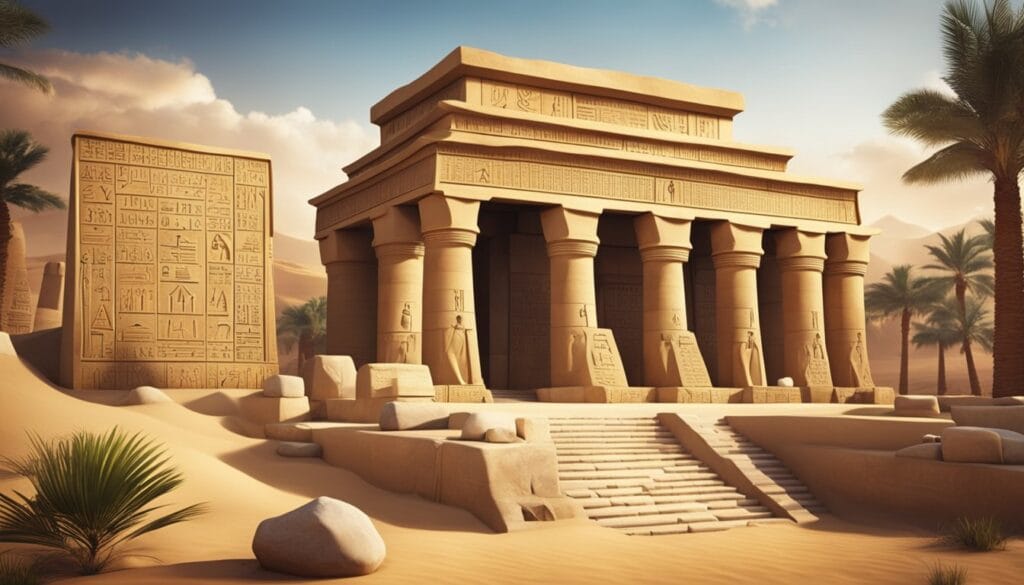Who hasn’t felt overwhelmed by life’s chaos, searching for balance and order? Imagine a system that weathered thousands of years, guiding people with timeless wisdom. Welcome to the captivating world of the 11 Laws of Maat.
At the heart of ancient Egyptian civilization, the Goddess Maat symbolized harmony, truth, and justice, crucial concepts to a society yearning for stability. These laws, grounded in the Feather of Truth, served as a moral compass, aligning individuals with universal order.

Has the modern world forgotten these ancient truths? Don’t let the word “ancient” fool you; the principles of Maat remain relevant today, offering an authentic path to a life steeped in purpose. Ancient Egyptians didn’t just admire Maat; they embodied her laws in daily life, believing in profound afterlife consequences.
How cool is it that these laws, crafted in antiquity, still resonate with us as we navigate our contemporary challenges? Are you curious to learn how these ancient laws can inform modern practices and bring more harmony into your life?
Key Takeaways
- Maat embodies harmony, truth, and justice.
- The 11 Laws guide individuals with timeless wisdom.
- Ancient principles can inform modern practices.
The Origins of Maat
Imagine a world where harmony and justice were paramount. The Ancient Egyptians brought this world to life through the concept of Maat, which encompassed order, truth, and justice. Understanding these principles offers us a glimpse into their complex spirituality and governance.
Conceptualization in Ancient Egyptian Culture
Have you ever wondered how concepts like order and harmony shaped one of the greatest civilizations? For the Ancient Egyptians, Maat wasn’t just an idea; it was a critical component of their cultural and spiritual life. They saw Maat as the foundation for the entire cosmic order and as a force combating chaos, known as Isfet. This belief united their religious and ethical systems, shaping their daily lives.
People believed that practicing Maat ensured the world functioned smoothly, influencing everything from law to personal conduct. It’s intriguing how such an ancient concept permeated every layer of society, don’t you think? Maat was the very thread that held together the fabric of Egyptian civilization.
Symbolism and Personification of Maat
Ever heard of the Feather of Truth? It’s one of the most captivating symbols linked to Maat, used during the judgment of the dead. Maat was not just a cosmic principle; she was also personified as a goddess. Picture her depicted with a feather in her headdress, embodying justice and balance.
As with many Ancient Egyptian symbols, the feather represented more than it appeared—it signified lightness and fairness. When souls entered the afterlife, their hearts were weighed against this feather. If the heart was lighter or equal in weight, the soul was deemed virtuous. Isn’t that a profound image of justice?
Maat and the Pharaohs
What role did Maat play in governance? Central, actually! Pharaohs were seen as earthly manifestations of gods, and their primary duty was to uphold Maat. Think of pharaohs as the keepers of order and equilibrium, ensuring justice and prosperity throughout the land.
Each ruler was considered the embodiment of Maat on Earth. Public and spiritual duties were intertwined, and decisions were scrutinized to align with this celestial order. The prosperity and stability of the entire kingdom depended heavily on how well the pharaoh embodied and practiced Maat. Such was their devotion to this principle.
The Central Tenets of Maat

The philosophy of Maat is a beautiful tapestry woven with the threads of Truth, Justice, and Balance. At the core of this ancient wisdom are principles that guided the Ancient Egyptians in creating a harmonious society. Below, we explore how these beliefs influence everyday lives and the universe.
Understanding the 11 Laws
Have you ever wondered what drove Ancient Egyptians to maintain such a structured and ethical life? The 11 Laws of Maat might hold the key. These laws are not just rules but embody virtues like Justice, Truth, and Order. They’re guiding principles for moral and ethical life.
The teachings emphasize living in harmony with others, which was essential for maintaining Social Order. These laws were seen as divine commands, with roots in the teachings of Ra Un Nefer Amen, who connected them to the 11 Laws of God. Think of them as ethical pillars upon which the society stood, nurturing a collective sense of integrity and righteousness that underpinned Egyptian social life.
Maat’s Influence on Daily Life
You might be curious about how Maat influenced day-to-day activities of the Ancient Egyptians. Picture this: every action, from farming to politics, was carried out with an eye towards maintaining balance and order. This wasn’t about rigid enforcement; rather, it was about living in a way that reflected universal truths and justice.
Homes and communities were arenas of ethics, where the principles of Maat encouraged fairness and harmony. People acted with consciousness of the Cosmic Order and moral conduct was celebrated. The balance that Maat required was believed crucial to ensuring a successful passage to the afterlife realms like Duat or Aaru. The influence of these laws had a ripple effect, leading to a cohesive and just society.
Balance and Cosmic Order
What is the tie between the stars and everyday behavior, you ask? Maat is not only about earthly life but also about aligning with the Cosmic Order. The ancient Egyptians believed that the universe thrived on these principles, thus rooting their existence in maintaining this balance. Harmony and balance were reflected in everything: from art to architecture.
This pursuit of balance compelled humans to act not just for themselves but for society and nature. By following the principles of Maat, they hoped to maintain cosmic equilibrium and ensure the universe remained in a state of order. It’s as if the universe had a rulebook, and everyone was a player in maintaining its harmony.
The 11 Laws of Maat in Practice

Exploring how the principles of Maat manifest in everyday life reveals a profound commitment to Truth, Justice, Order, and Harmony. Ancient Egyptians seamlessly integrated these teachings into their spirituality and personal development, emphasizing ethics, rituals, and spiritual strength.
Ethical Principles and Commitments
Living in alignment with the Laws of Maat requires deep ethical commitment. You strive to embody Truth and Justice in daily interactions, avoiding actions like lying, stealing, or swindling offerings. Ancient Egyptians valued these principles, believing that sins like these disrupted order.
Ensuring personal growth involves practicing Integrity and actively avoiding committing sin. An adherence to such ethics empowers you to create harmony in relationships and society. It conveys a sincere respect for others and the sacred.
Achieving this is more than avoiding wrongdoing. It’s about making conscious choices that reflect your values. Imagine a compass guiding you towards fairness and balance. Following these principles can increase not only personal integrity but also the wellbeing of the community.
Rituals and the Application in Temples
Temples played a key role in actualizing Maat’s laws through rituals. Ancient Egyptians performed ceremonies to maintain Order and Harmony, believing this linked them to the divine realm. These rituals demonstrated devotional acts aligned with spiritual and religious practices.
Priests, acting as stewards of spiritual wisdom, ensured rituals resonated with the divine principles. Participation was believed to cleanse the spirit and uphold societal norms, making religion a tool for moral persuasion. Imagine how Power and Spirituality intertwined here, reinforcing Maat’s laws.
Rituals weren’t mere routines; they were immersive spiritual experiences. Engaging deeply in these practices empowered personal and communal transformation. Are you curious how these traditions influence modern spiritual practices today?
Personal Growth and Spiritual Strength
Embracing Maat offers a path to significant Personal Development. Fostering personal growth encompasses nurturing Wisdom, Intuition, and Spiritual Strength. These attributes empower you to transcend challenges, elevating moral courage and emotional resilience.
Ancient Egyptians perceived spiritual development as a journey. Integrating these practices into daily life fosters inner peace and clarity. This pursuit of personal excellence corresponds with nurturing a profound connection to the universe and spiritual order.
Spiritual Power grows with each ethical action, forming a ripple of positive influence. Are you ready to embark on this journey? Engaging with Maat invites you to explore profound depths of personal and spiritual evolution.
Maat and the Afterlife

In ancient Egyptian belief, Maat played a critical role in the afterlife, emphasizing balance and truth. Souls were judged in the Duat, facing the Feather of Truth, defining the path to eternal peace in Aaru.
Judgment in the Duat and the Feather of Truth
Imagine finding yourself in the mystical realm of Duat, where your heart is weighed against Ma’at’s Feather of Truth. It’s a bit like a cosmic courtroom. The heart, housing a person’s deeds and intentions, must balance against the feather, representing truth and order.
If the scales balance perfectly, you get a ticket to Aaru, the field of reeds. This concept echoes in the well-known Book of the Dead, particularly the Papyrus of Ani. Fail the test, though, and a certain creature called Ammit, a frightful mix of lion, hippopotamus, and crocodile, stands ready to devour one’s heart. Scary, right? The judgment underscores the importance of a life lived in accordance with Maat’s principles, emphasizing morality and truth.
The 42 Laws of Maat and Their Significance
The 42 Laws of Maat, or Negative Confession, isn’t a Netflix series, but a set of ethical and moral rules. These rules guided living a life in balance and harmony. Picture confessing to 42 different gods, asserting you’ve lived right—from not stealing to speaking truth.
These declarations played a crucial role during the judgment phase in the Duat. If you’ve got time, you might want to glance at these laws yourself, often detailed in ancient texts like the Papyrus of Ani. They highlight Maat’s essence: maintaining cosmic order and personal integrity.
The Concept of Aaru and Eternal Peace
Now, on to Aaru—kind of like the heaven of ancient Egypt. This paradise, filled with lush reeds, symbolizes peace and reward for those deemed worthy. It’s where you’d find your ancestors, having passed the Feather of Truth test.
The idea is simple yet profound: live a life of truth and morality in alignment with Maat’s principles, and you’ll enjoy an afterlife of contentment. Aaru embodies the ultimate goal of one’s journey through life and death—a destination of tranquility and harmony. Engaging with the concept of Aaru invites you to consider how ancient Egyptians prioritized the values of Maat to ensure eternal peace.
Historical and Modern Interpretations

When exploring the 11 Laws of Maat, you come across intriguing parallels and contrasts between ancient beliefs and current perspectives. This section discusses how these age-old principles relate to other ethical systems, remain relevant in today’s world, and have left their mark on various aspects of culture and literature.
Comparisons to Other Religious and Ethical Systems
Have you ever wondered how Maat’s principles fit in with other belief systems? In ancient Egypt, Maat represented Truth, Order, and Harmony, forming the ethical backbone of society. These ideals resemble those found in Christianity, Buddhism, and even Stoicism, which emphasize justice and moral order. Unlike more rigid doctrines, Maat centered around the balance between chaos and order. It encouraged a flexible approach to ethics.
Consider how Maat differs from the commandments in Abrahamic religions, which often follow a set of absolute rules. By prioritizing harmony and order, Maat offers guidance that adapts to a complex, varied world. This makes Maat an interesting counterpart to other ethical traditions, which are often more prescriptive.
Maat’s Relevance Today
Why does Maat still matter in our modern world? Despite its ancient roots, the essence of Maat—focusing on balance and justice—resonates with contemporary themes such as social justice and environmental sustainability. Concepts like truth and order remain vital as society seeks stability amidst rapid change, emphasizing how ancient wisdom can guide modern life.
In workplaces, Maat encourages ethical decision-making. Leaders often seek to balance profitability with social responsibility, echoing Maat’s harmony between personal and communal interests. Schools may teach critical thinking, aiming to nurture well-rounded citizens echoing Maat’s principles of truth and knowledge.
The Legacy of Maat in Literature and Culture
How has Maat influenced literature and culture? From ancient texts to modern novels, Maat’s principles frequently appear. Literature often reflects Maat’s themes of justice and truth, shaping storytelling across time.
The iconic scene of weighing the Feather of Truth in the afterlife has inspired countless narratives about moral reckoning.
Cultural influences are evident, too. Movies and TV shows often draw on Maat’s ideals, whether it’s through a hero’s quest for justice or the portrayal of societies striving for harmony.
Maat offers a timeless framework for creativity, underscoring its enduring legacy in shaping our understanding of morality and fairness.




